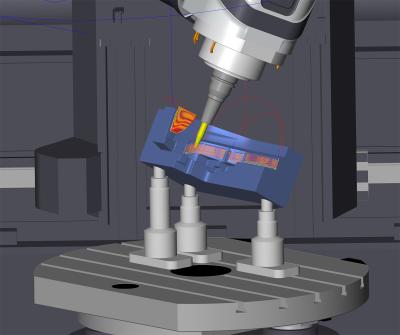
OPEN MIND Technologies AG, a leading developer of CAD/CAM software solutions worldwide, has introduced its latest hyperMILL® 2021.2 CAD/CAM software suite which offers users innovative and enhanced features for efficient, user friendly machining in applications ranging from 2.5D to 5-axis. “With our continued focus on providing a rich, simplified user experience, the latest version of hyperMILL® offers enhanced machining strategies, increased options for data feedback, as well as more convenience,” said Mr. Alan Levine, Managing Director of OPEN MIND Technologies USA, Inc.
Resulting in simplified programming and increased process reliability, hyperMILL® VIRTUAL Machining NC code-based machine simulation has also been enhanced. Within the VIRTUAL Machining Optimizer module which links individual part programs with smooth and safe connections, the cutter is able to remain close to the workpiece, violations of the axis limitations are now detected and movement sequences are optimized accordingly. There is also a new option in VIRTUAL Machining to apply a special approach and retract strategy to machines where the cutting tool can be retracted into a tunnel.
A forerunner in CAM Additive Manufacturing, OPEN MIND has introduced more capabilities in hyperMILL® 2021.2 ADDITIVE Manufacturing including a Weave Mode. This new mode generates a toolpath in a wave-shaped or zigzag movement, to apply material to contours or to fill areas, allowing the application area to be widened and the thickness to be increased for the individual movement. This continuous application also improves the metallurgical properties of the applied material.
In the integrated hyperCAD®-S CAD module, additional file formats for import and export have been added including SAT as standard ACIS text, and OBJ and 3MF for importing mesh data. Also, electrode creation has been improved via the optimized selection of the raw material. To support EDM machining, the hyperCAD®-S Electrode Converter can now be used to create import files for several EDM machines such as Exeron, Zimmer & Kreim and OPS-INGERSOLL.
For increased quality and ease of use, enhancements to some CAM cycles are offered in hyperMILL® 2021.2 such as 3D and 5-axis Equidistant Finishing capabilities that define the milling area by selecting bounding curves so that individual areas on a surface model can be targeted. With 3D ISO Machining, multiple bounding curves can now be used to allow different areas to be machined in one job. In addition, 3D Z-level Shape Finishing includes several innovative features to improve machining quality, including optimized sorting of toolpath, smooth overlap at boundary, free tool geometry and trim toolpath to stock.
For improved clarity, hyperMILL® 2021.2 also has new functions that provide better feedback during CAM programming. Automatic Stock Display displays stock automatically for any machining job. Also, there is a new Preview of Selected Entities feature that highlights entities such as curves, faces or points when a job is selected. And for component alignment at a touch of a button, a new BEST FIT feature aligns the NC program automatically to the component position, eliminating manual alignment and optimizing the options offered by VIRTUAL Machining.
Contact Details
Related Glossary Terms
- computer-aided design ( CAD)
computer-aided design ( CAD)
Product-design functions performed with the help of computers and special software.
- computer-aided manufacturing ( CAM)
computer-aided manufacturing ( CAM)
Use of computers to control machining and manufacturing processes.
- electrical-discharge machining ( EDM)
electrical-discharge machining ( EDM)
Process that vaporizes conductive materials by controlled application of pulsed electrical current that flows between a workpiece and electrode (tool) in a dielectric fluid. Permits machining shapes to tight accuracies without the internal stresses conventional machining often generates. Useful in diemaking.
- gang cutting ( milling)
gang cutting ( milling)
Machining with several cutters mounted on a single arbor, generally for simultaneous cutting.
- milling
milling
Machining operation in which metal or other material is removed by applying power to a rotating cutter. In vertical milling, the cutting tool is mounted vertically on the spindle. In horizontal milling, the cutting tool is mounted horizontally, either directly on the spindle or on an arbor. Horizontal milling is further broken down into conventional milling, where the cutter rotates opposite the direction of feed, or “up” into the workpiece; and climb milling, where the cutter rotates in the direction of feed, or “down” into the workpiece. Milling operations include plane or surface milling, endmilling, facemilling, angle milling, form milling and profiling.
- numerical control ( NC)
numerical control ( NC)
Any controlled equipment that allows an operator to program its movement by entering a series of coded numbers and symbols. See CNC, computer numerical control; DNC, direct numerical control.
- surface model
surface model
3-D model defined by surfaces. The surface consists of polygons.
- toolpath( cutter path)
toolpath( cutter path)
2-D or 3-D path generated by program code or a CAM system and followed by tool when machining a part.

